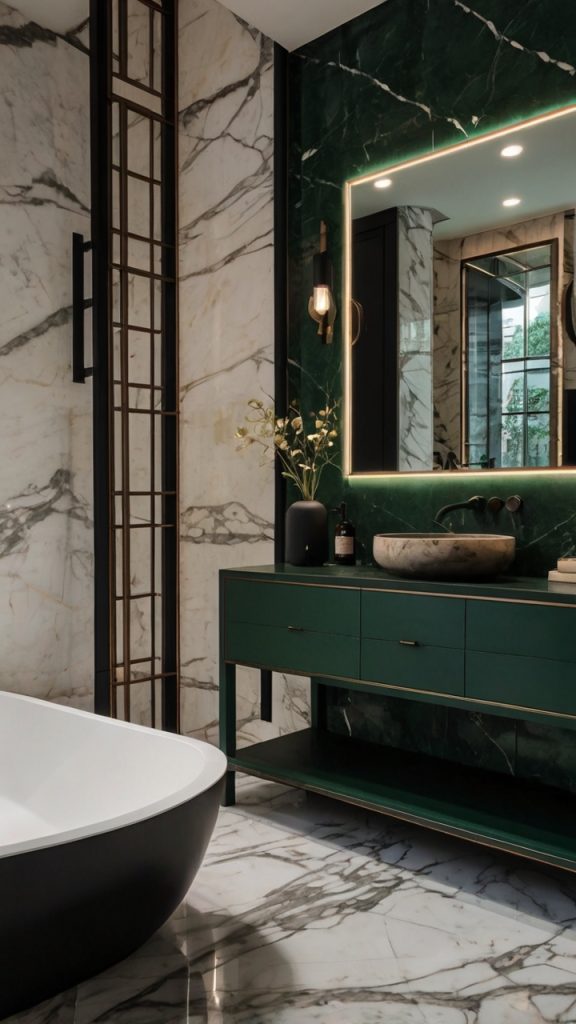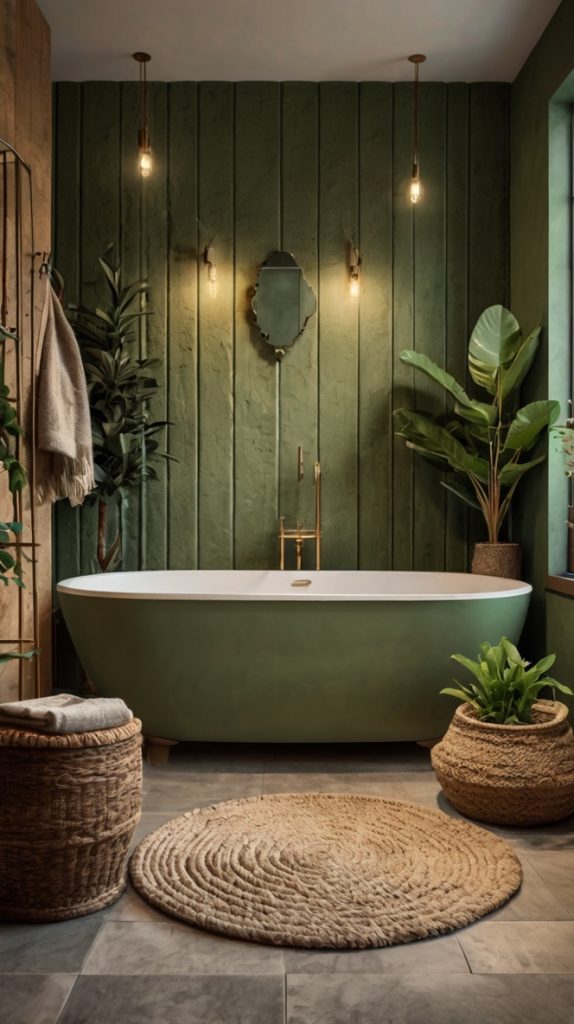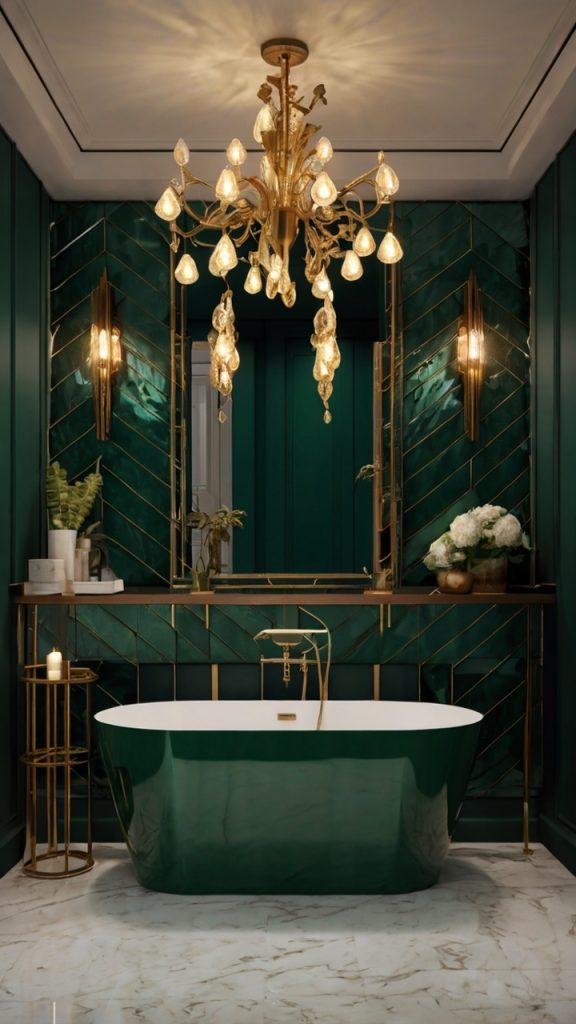15 Stunning Moody Dining Room Ideas and Cozy Chic Vibes
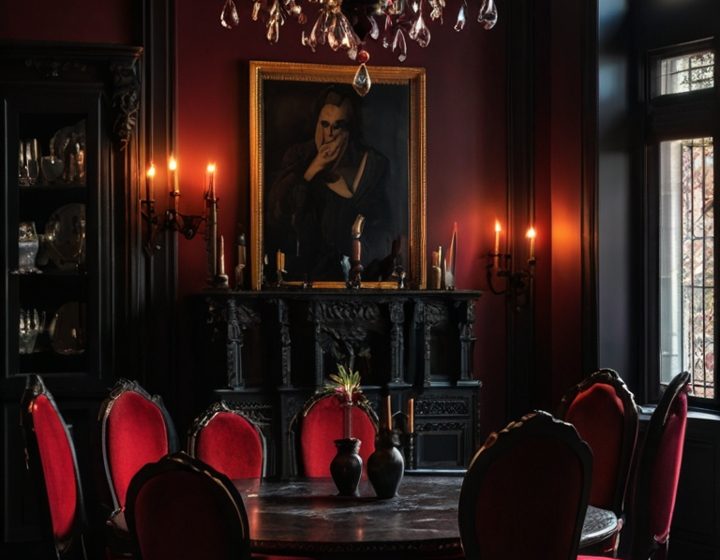
You know that feeling when you walk into a restaurant with dim lighting, rich colors, and an atmosphere so thick you could cut it with a knife? That’s the vibe we’re chasing today. I’ve been obsessed with moody dining rooms ever since I accidentally painted my walls charcoal gray instead of “gentle dove” (thanks, misleading paint chip!). Turns out, that happy accident launched my love affair with dramatic dining spaces.
Here’s the thing: moody doesn’t mean depressing. We’re talking sophisticated, atmospheric, and downright sexy dining rooms that make every meal feel like an event. Whether you’re hosting a dinner party or just eating Tuesday night tacos, these spaces transform the mundane into something special.
Dark Velvet Elegance
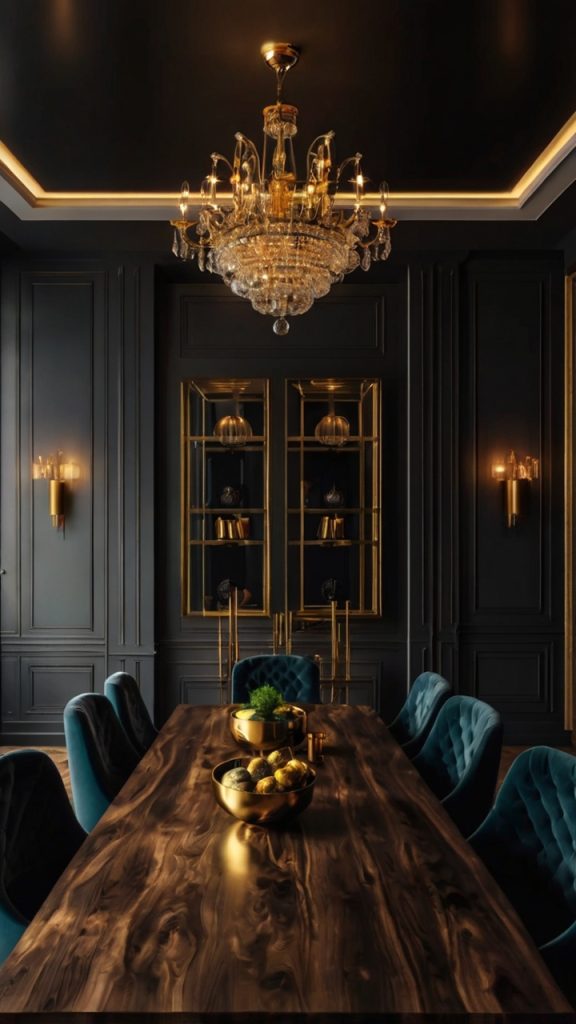
Let me tell you about my friend Sarah’s dining room transformation. She went full velvet, and honestly? I’m jealous. Dark velvet chairs are the quickest way to add instant drama to any dining space. Think deep burgundy, midnight blue, or forest green upholstery that practically begs you to sit down and stay awhile.
The texture game here is crucial. Velvet catches light differently throughout the day, creating this gorgeous depth that flat fabrics just can’t match. Pair those plush chairs with a dark wood table – walnut or ebony work beautifully – and you’ve got yourself a recipe for elegance.
Want to really nail this look? Here’s what works:
- Tufted velvet dining chairs in jewel tones
- A substantial dining table with a matte finish
- Layered lighting (chandelier + wall sconces)
- Rich, textured curtains that pool slightly on the floor
- Metallic accents in warm tones like brass or copper
Making It Work in Small Spaces
You might think velvet elegance needs a mansion-sized dining room. Nope! I’ve seen tiny apartments pull this off by using just two velvet host chairs at the ends of the table. The key is balance – don’t overwhelm the space, but don’t be afraid to go bold either.
Moody Minimalist Chic
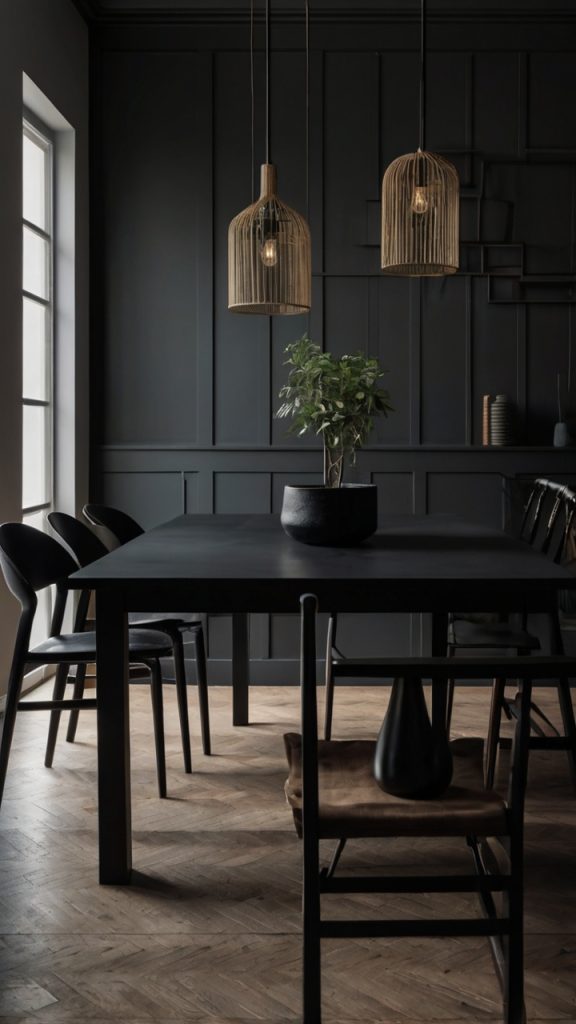
Now this might sound like an oxymoron, but hear me out. Moody minimalism combines the drama of dark colors with the zen of clean lines. I discovered this style when I visited a friend’s loft in Brooklyn (of course it was Brooklyn), and it completely changed my perspective.
Think charcoal walls, a sleek black dining table, and maybe four chairs – that’s it. No clutter, no fuss, just pure atmospheric simplicity. The beauty lies in the quality over quantity approach. Every piece needs to earn its place.
The color palette stays tight:
- Blacks and charcoals
- Deep grays
- Occasional white for contrast
- Natural wood in dark stains
- Single accent metal (pick one and stick with it)
The Art of Negative Space
What makes moody minimalism work? Space. Lots of it. You’re creating drama through absence rather than abundance. One stunning piece of art on a dark wall beats a gallery wall every time in this style.
Gothic Luxe Dining
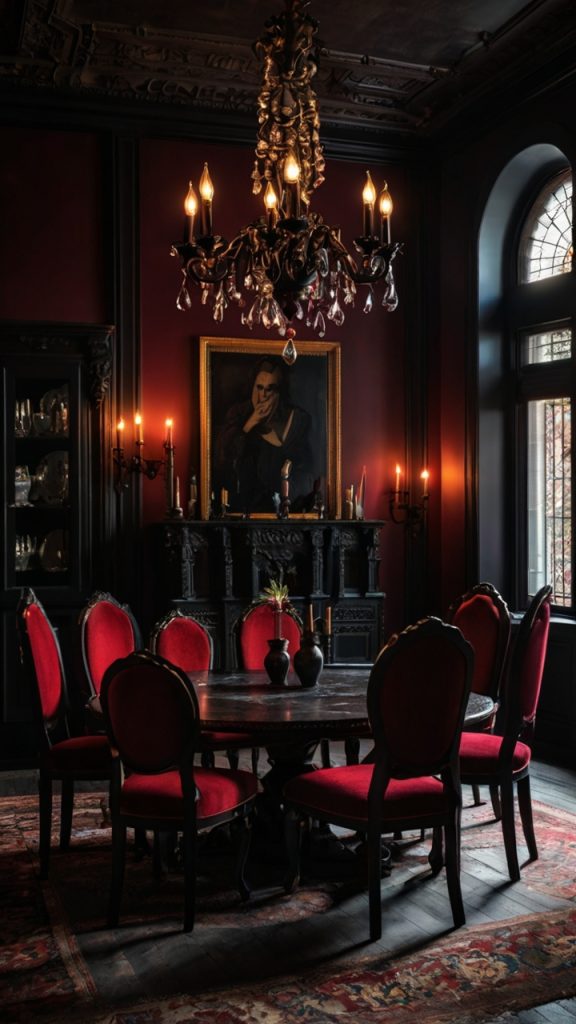
Okay, before you picture vampire dinner parties (though honestly, that sounds fun), modern gothic luxe is way more sophisticated than you’d think. We’re talking refined darkness with ornate details that would make any design snob swoon.
I stumbled into this style after inheriting my grandmother’s ornate mirror. Instead of relegating it to storage, I hung it in my dining room against a black wall. Game changer! The contrast between elaborate details and dark backgrounds creates this incredible visual tension.
Essential elements include:
- Ornate mirrors or frames in gold or silver
- Dramatic chandeliers (think crystal or wrought iron)
- Rich, heavy fabrics
- Antique or antique-inspired furniture
- Candlesticks everywhere (and I mean everywhere)
Also Read: 15 Stunning Dining Room Lighting Ideas for Elegant Spaces
Deep Jewel Tone Haven
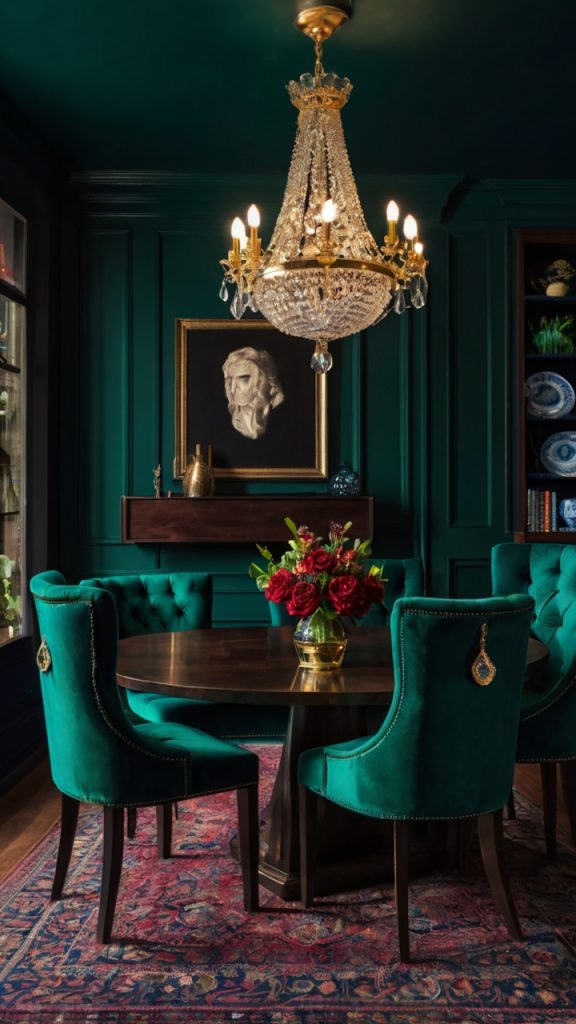
This is where things get really juicy. Jewel tones – emerald, sapphire, amethyst, ruby – create depth without going full black. My dining room currently rocks deep teal walls, and every dinner guest comments on them. Every. Single. One.
The trick with jewel tones? Layer them. Don’t just paint the walls emerald and call it a day. Add sapphire velvet chairs, amethyst glassware, maybe a ruby Persian rug. It sounds like it could be overwhelming, but when you stick to the jewel family, everything plays nice together.
Balancing the Intensity
Here’s what I learned the hard way: jewel tones need breathing room. Break them up with:
- Natural wood elements
- Metallic accents (gold and brass are your friends)
- Crisp white linens
- Clear glass or crystal
- Strategic lighting to prevent cave vibes
Candlelit Rustic Charm
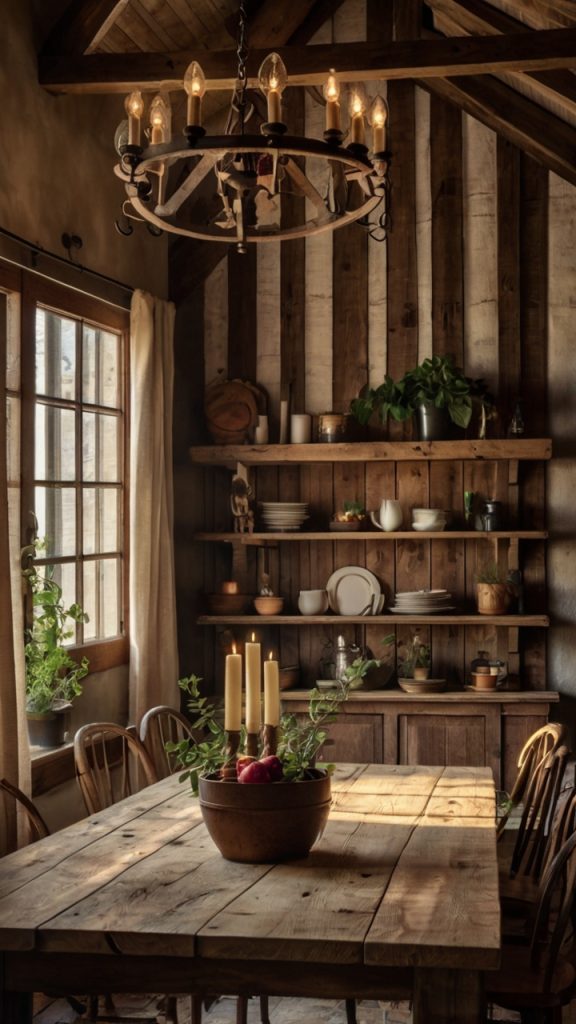
Who says moody can’t be cozy? This style combines the warmth of rustic elements with atmospheric lighting for a space that feels like a romantic tavern. And yes, I’m totally here for it.
Exposed wood beams, rough-hewn tables, and enough candles to worry your insurance agent – that’s the formula. I helped my sister design her dining room this way, and now she hosts every family gathering. Coincidence? I think not.
Key ingredients for this recipe:
- A substantial farmhouse-style table in dark wood
- Mismatched vintage chairs (intentionally mismatched, mind you)
- Candles in varying heights – pillar, taper, votive
- Wrought iron elements
- Textured walls (exposed brick or dark shiplap work great)
Black & Gold Drama
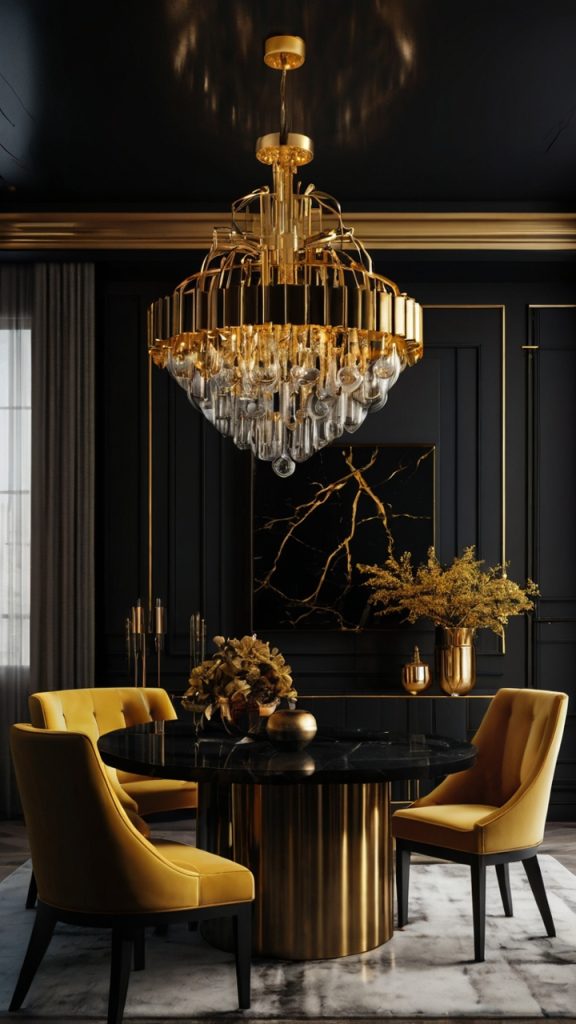
Let’s talk about the ultimate power couple in interior design. Black and gold together create instant sophistication with just a hint of Vegas (the classy parts of Vegas, IMO). This combo works because it’s bold without being chaotic.
I went this route in my previous apartment’s dining room. Black walls, gold-framed art, brass light fixtures, and a black lacquered table that reflected everything. Did it photograph well for Instagram? You bet. Did it also make every meal feel special? Absolutely.
The Golden Rules (Pun Intended)
Follow these guidelines for black and gold success:
- Choose your gold tone and stick with it (mixing brass and rose gold gets messy)
- Use gold as an accent, not the main event
- Incorporate texture to prevent flatness
- Add plants for life and contrast
- Consider black marble with gold veining for next-level luxury
Also Read: 15 Stunning Modern Farmhouse Dining Room Ideas to Try
Moody Botanical Retreat
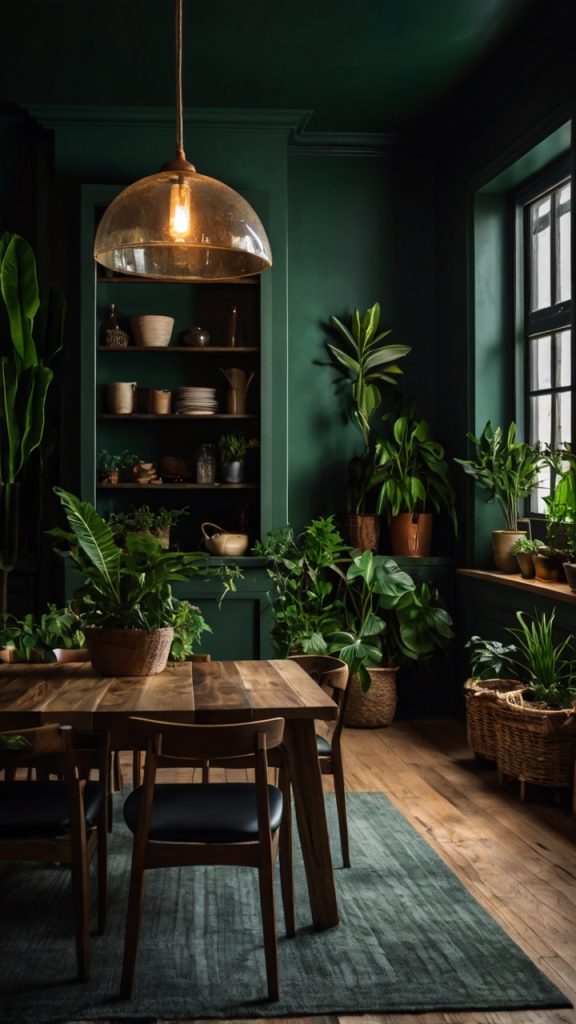
Plants and moody interiors? They’re not mutually exclusive! Dark walls make greenery pop like nothing else. This style brings nature indoors while maintaining that atmospheric edge we’re after.
Picture this: charcoal walls, a live-edge walnut table, and plants everywhere – hanging, potted, climbing. Add some botanical prints in dark frames, and suddenly your dining room feels like a sophisticated greenhouse. FYI, this also gives you an excuse to buy more plants 🙂
Best plants for moody spaces:
- Monstera deliciosa (those dramatic leaves!)
- Snake plants (practically indestructible)
- Pothos (trails beautifully from shelves)
- Fiddle leaf fig (if you’re feeling ambitious)
- ZZ plants (thrives in low light)
Shadowy Industrial Edge
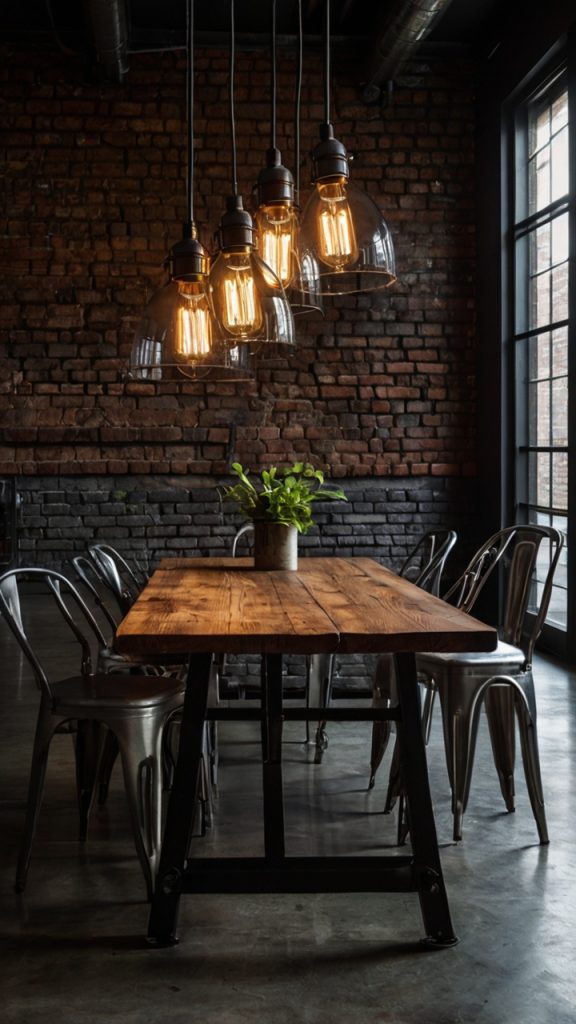
Industrial style gets moody when you embrace the shadows. We’re talking exposed pipes, concrete elements, and metal everything, but in darker tones that create depth and drama.
My buddy converted his garage into a dining space using this aesthetic. Polished concrete floors, black metal chairs, Edison bulb lighting, and a reclaimed wood table that could probably survive a nuclear blast. It shouldn’t work, but it absolutely does.
Industrial Elements That Matter
Focus on these features:
- Metal and wood combinations
- Exposed architectural elements
- Factory-style lighting
- Leather accents
- Raw, unfinished textures
- Open shelving in black metal
Navy & Walnut Harmony
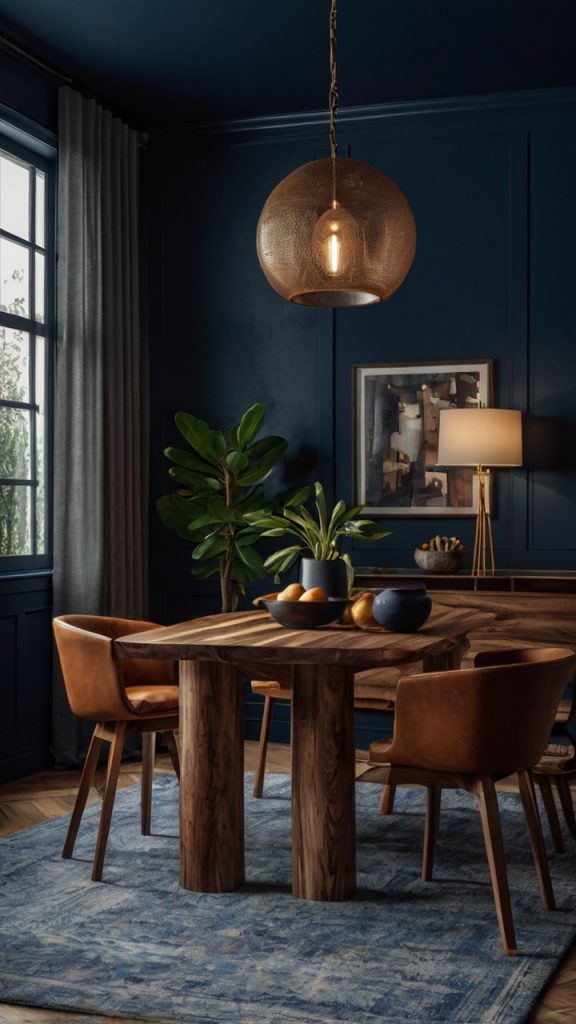
This combination is like the sophisticated older sibling of nautical style. Navy and walnut together create warmth without sacrificing moodiness. It’s approachable yet dramatic – kind of like a cashmere sweater with leather pants.
I’ve seen this work beautifully in both traditional and modern spaces. Navy walls or ceiling (yes, ceiling!), walnut furniture, and brass accents tie everything together. The warmth of the wood prevents the navy from feeling cold.
Why this combo works:
- Natural wood grain adds organic texture
- Navy is moody without being black
- Both colors age beautifully
- Works with multiple design styles
- Easy to accessorize
Also Read: 15 Stunning Kitchen and Dining Room Ideas for Cozy Spaces
Dark Romantic Vintage
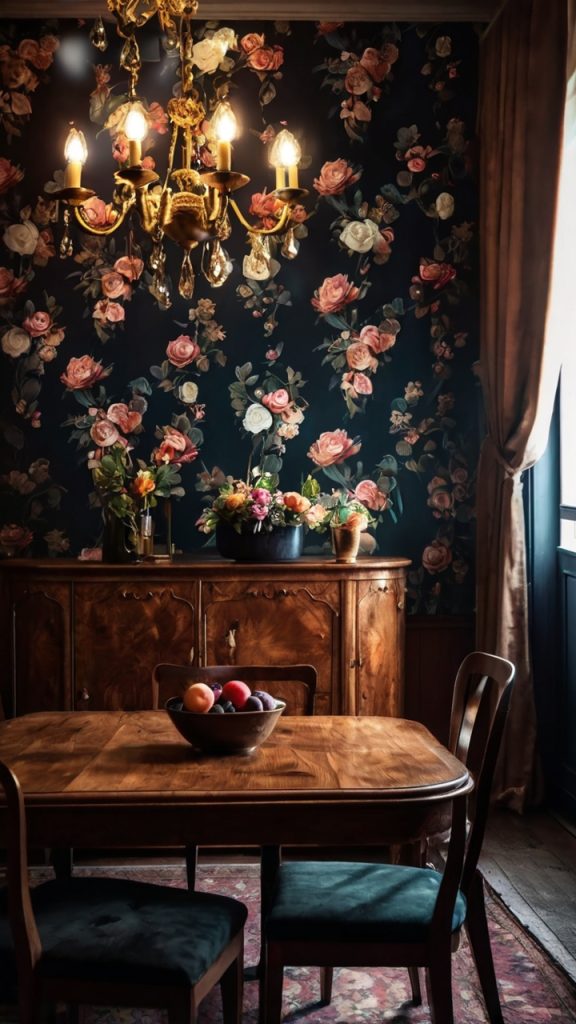
Romance doesn’t have to mean pink and frilly. Dark romantic vintage takes all those swoony elements and gives them an edge. Think Victorian meets modern goth, but make it livable.
This style loves layers. Vintage lace over dark wood, antique candelabras, dried flowers, old books, and mirrors that have seen better days. My aunt’s dining room embodies this perfectly – it feels like a beautiful, slightly haunted tea room.
Creating the Romance
Essential elements include:
- Vintage or antique furniture with curves and details
- Layered textiles in rich colors
- Aged metallics (tarnished silver, anyone?)
- Moody floral wallpaper or art
- Soft, diffused lighting
- Collections displayed thoughtfully
Emerald & Brass Opulence
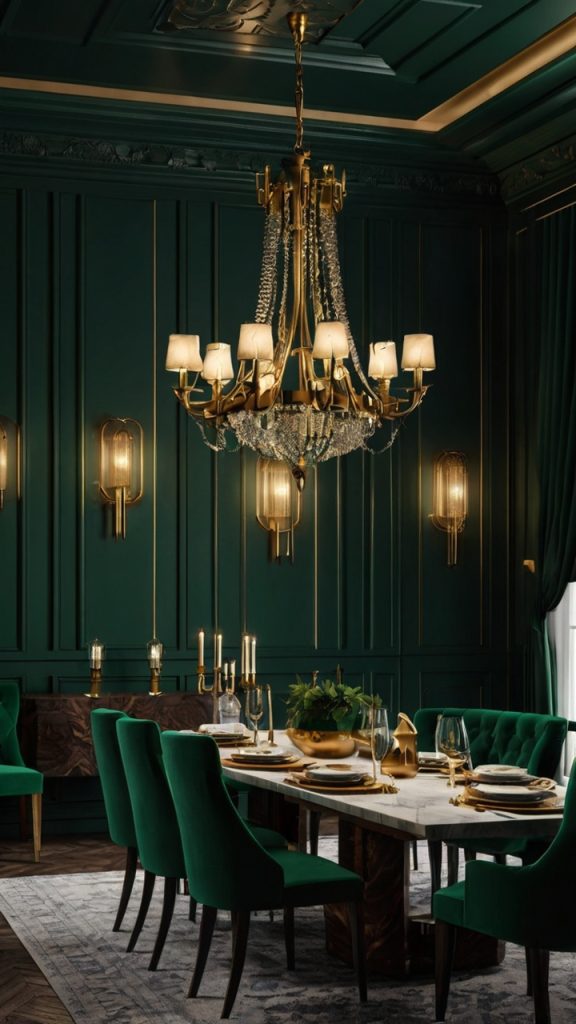
Green is having a moment, and emerald takes it to luxury level. Paired with brass, you get a space that feels both fresh and timeless. This combo reminds me of an exclusive private club where important deals get made over brandy.
I painted one accent wall emerald in my dining room last year. Combined with my brass chandelier and dark wood table, it created this jewel box effect that makes me feel fancy even when I’m eating leftover pizza.
Making emerald work:
- Use it sparingly but boldly (one wall or key furniture pieces)
- Balance with neutrals
- Layer different green tones
- Add brass in lighting and hardware
- Include natural textures
Cozy Monochrome Mood
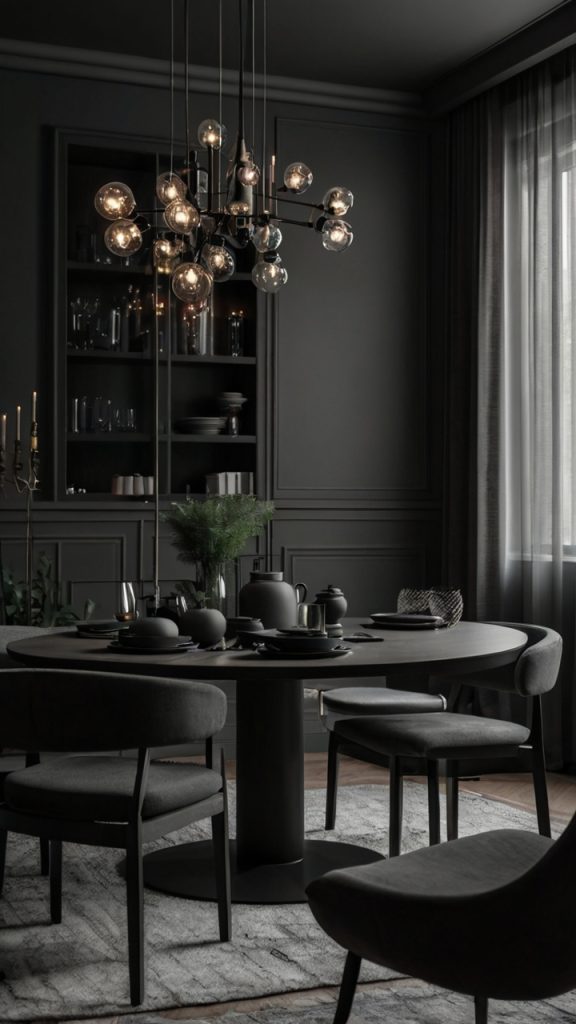
Monochrome doesn’t mean boring. By sticking to variations of one color, you create depth through texture and tone rather than contrast. It’s surprisingly sophisticated and definitely moody.
Gray is the obvious choice, but I’ve seen stunning monochrome dining rooms in deep blue, forest green, even burgundy. The key? Mix matte and glossy finishes, incorporate different materials, and play with lighting.
Monochrome Must-Haves
To nail this look:
- Choose your color and explore its full range
- Mix textures obsessively
- Include metallics in the same color family
- Layer lighting at different heights
- Add one tiny pop of contrast (just one!)
Moody Scandinavian Touch
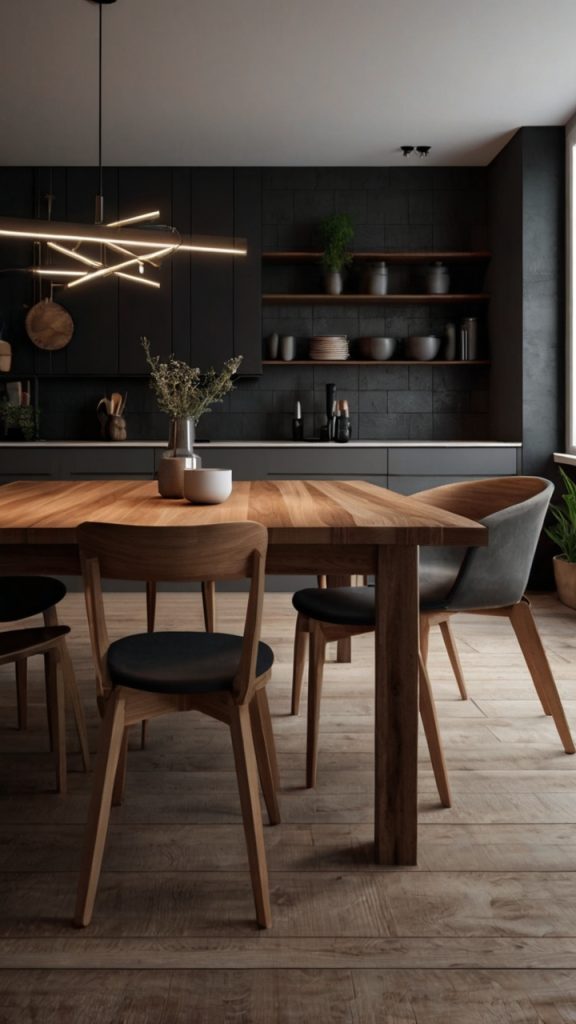
Scandinavian design isn’t all white walls and light wood. Dark Scandi keeps the functionality but adds drama. It’s minimalism’s moodier cousin who studied abroad and came back more interesting.
Think black walls, natural wood, cozy textiles, and that signature Scandinavian simplicity. But instead of bright and airy, we’re going for intimate and enveloping. It works especially well in colder climates where you want that cocoon feeling.
Elements to include:
- Clean lines and functional design
- Natural materials in darker tones
- Hygge-inspired textiles
- Statement lighting (those Danes know their lamps)
- Minimal but meaningful decor
Smoky Glass & Mirror Magic
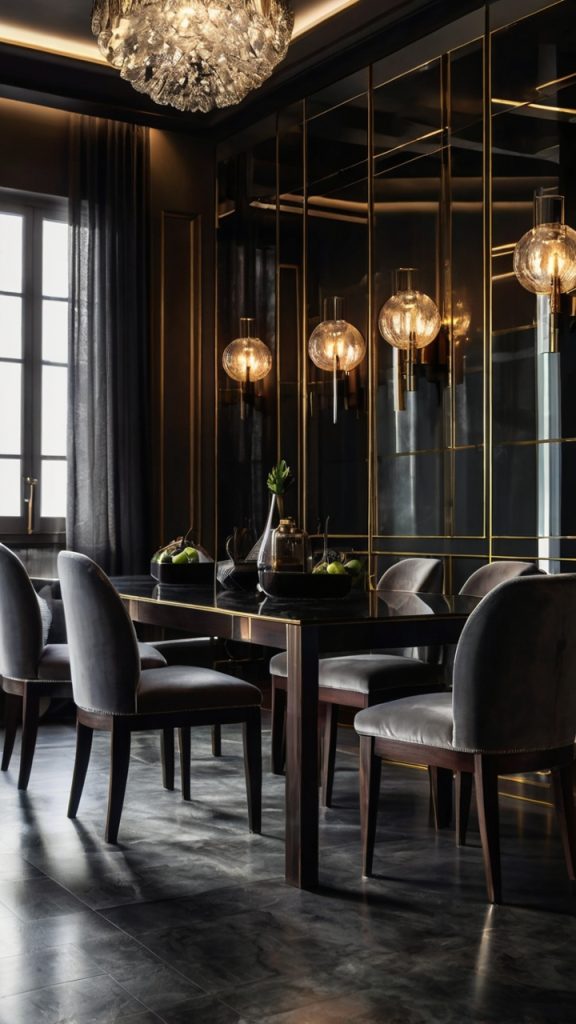
Want instant atmosphere? Smoky glass and mirrors create depth, reflection, and mystery. This approach works incredibly well in smaller dining rooms where you need to create the illusion of space while maintaining moodiness.
I discovered this trick accidentally when I hung a vintage smoky mirror I found at an estate sale. Suddenly my tiny dining room felt twice as big and three times as interesting. Add smoky glass pendant lights and a mirrored bar cart, and you’ve got magic.
Reflection Strategy
Here’s how to use reflective surfaces effectively:
- Position mirrors to reflect your best features (chandelier, art, windows)
- Use smoky or antiqued glass for softness
- Mix matte and reflective surfaces
- Consider a mirror gallery wall on one side
- Add mercury glass accessories
Twilight Color Palette
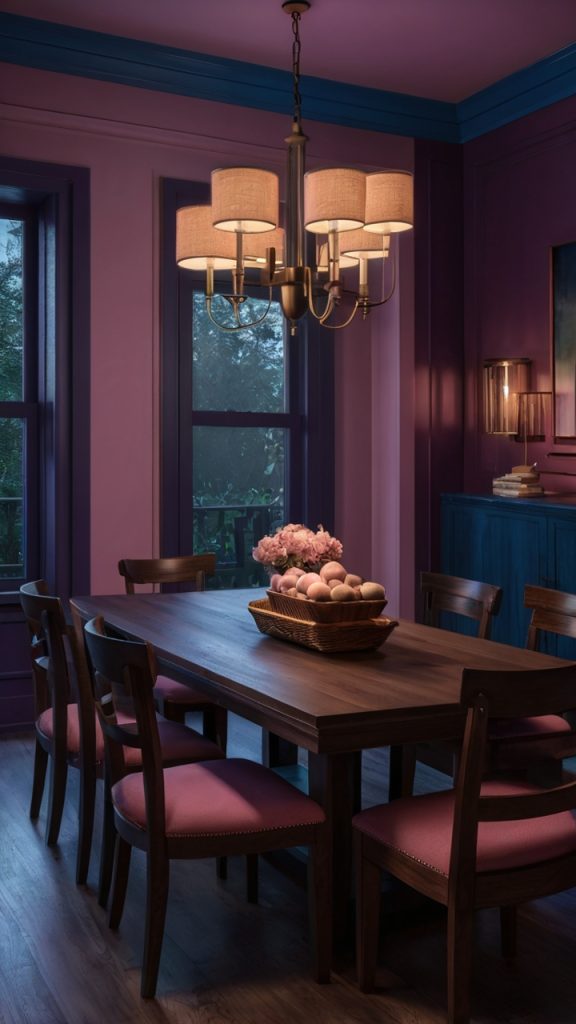
This is my personal favorite – colors that capture that magical hour between day and night. Deep purples, dusty blues, soft grays, and muted pinks create an ethereal moodiness that feels both calming and dramatic.
Ever notice how everything looks better at twilight? This palette brings that feeling indoors permanently. I’ve been experimenting with this in my current dining room, layering dusty purple walls with deep blue velvet chairs and gray linens.
Twilight colors that work:
- Dusty purple (not quite gray, not quite lavender)
- Deep periwinkle blue
- Charcoal with blue undertones
- Muted mauve
- Soft black (yes, that’s a thing)
Bringing It All Together
The beauty of twilight colors? They shift with your lighting. During the day, they’re subtle and sophisticated. At night, with candles and dim lighting, they become deeply atmospheric.
Final Thoughts
Creating a moody dining room isn’t about following rules – it’s about creating atmosphere. Whether you go full gothic or subtly shadowy, the goal is a space that makes dining feel like an experience.
Start small if you’re nervous. Paint one wall, add some velvet chairs, or just dim your lights and add candles. You don’t need to renovate everything at once. Trust me, I started with one accidentally dark wall and now I’m basically living in a very chic cave.
The best part about moody dining rooms? They’re forgiving. Dust doesn’t show as much on dark surfaces, candlelight makes everyone look good, and there’s something about a dramatic dining space that makes even takeout feel special. So go ahead, embrace the dark side – your dining room will thank you for it
